Comparative Advantage: Definition, How to Calculate & Examples
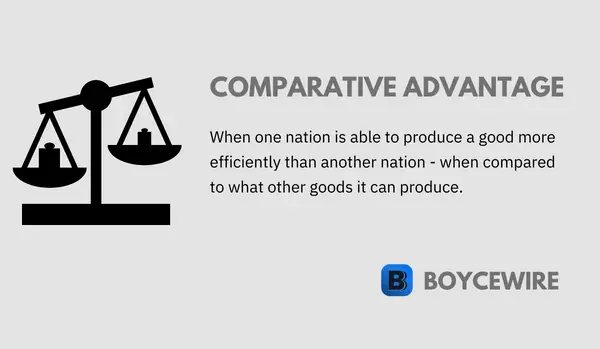
What is Comparative Advantage?
Comparative advantage is where a nation is able to produce a product at a lower opportunity cost. In other words, a nation sacrifices less of Good A to produce Good B than other nations. This is in sharp contrast to absolute advantage because a nation can have a comparative advantage but not actually be more efficient than other countries.
The law of comparative advantage was originally introduced by David Ricardo back in 1817. He defined it as a state by which one nation was more efficient at producing a certain good than another. However, unlike absolute advantage, comparative advantage considers opportunity cost.
Key Points
- Comparative advantage is where one nation can produce a good at a lower opportunity cost than another.
- It differs from absolute advantage in the fact that it considers opportunity cost. So the nation may be not have an absolute advantage, but is able to produce a good at a lower opportunity cost.
- When one country is hyper-efficient at creating a certain product, it would actually prove inefficient to focus on the production of other goods.
Comparative Advantage Examples
Comparative advantage is a concept best explained with an example. Let us consider two countries that produce both cars and motorbikes. The table below demonstrates what the country could produce if it expends all of its resources.
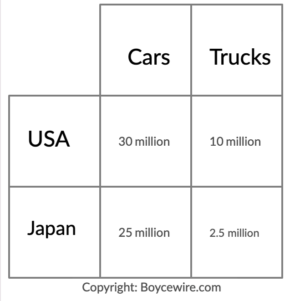
In this example, the US makes 30 million cars and 10 million trucks, whilst Japan produces 25 million cars and 2.5 million trucks. The US has an absolute advantage in producing both cars and trucks. However, it has a comparative advantage in trucks. This is because it is better at producing them. Although it is 1.2 times better than Japan in producing cars, it is 4 times better at producing trucks.
To explain, Japan could either produce 25 million cars or 2.5 million trucks. It may be reasonable to assume that it should produce cars because it can make more of them. However, it has a comparative advantage in the production of cars. This is because it is comparatively less efficient at producing trucks. So the opportunity cost is far greater. In other words, Japan is better at producing cars than trucks when compared to the US.
“Japan has a comparative advantage in producing cars as it has to give up fewer trucks than the US to do so.”
The keen-eyed reader may see that the US can produce more cars or trucks than Japan. So how does this translate into a comparative advantage? Well, it stems from the opportunity cost. If the US were to focus on producing cars, there would be few trucks because Japan is very inefficient at making them. So the US has to give up more trucks in order to produce a car than Japan.
Japan would have to give up 10 cars to produce 1 truck. This is because it can produce 25 million cars or 2.5 million trucks. By contrast, the US would have to give up 3 cars to produce 1 truck. So the opportunity cost of producing a truck is far lower than that of Japan.
It is for this reason that the US has a comparative advantage in producing trucks. Yet, Japan has an opportunity cost advantage in the production of cars. This is because it only has to give up 0.1 of a truck to produce a car. On the other hand, the US has to give up 0.33 of a truck to produce a car.
So the opportunity cost of producing a car in Japan is far lower. As a result, it is more efficient for Japan to produce cars and the US to make trucks.
Real-Life Comparative Advantage Example
To put things into context, let’s try and look at things from a different perspective.
Cristiano Ronaldo, a famous soccer star has a clear advantage over the average person in his ability. For instance, he is consistently rated as one of the best players in the world. Nevertheless, let us also assume that he has great musical ability.
He can’t focus on both his soccer and music without compromising his ability in one or the other. So which does he focus on? Well for each level of musical focus, he must give up his focus on soccer. This would be sub-optimal because he is one of the best in the world at soccer. So in terms of comparative advantage, he has one in soccer.
Even if Cristiano Ronaldo was an excellent musician, his football talents are much greater than his ability as a musician. At the same time, Mr. Doyle may be average at both music and football. Yet he has a comparative advantage as he has to give up much less of his football talent in order to focus on music.
Absolute Advantage vs Comparative Advantage
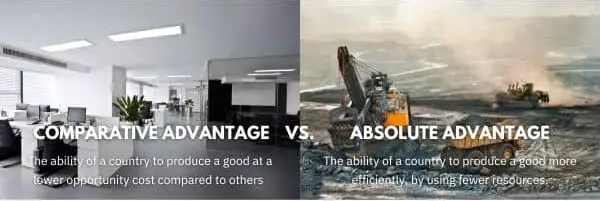
When a nation has an absolute advantage, it is completely more efficient. That is to say, it can create a product at a lower cost. By contrast, comparative advantage is where a country can produce a specific good at a lower opportunity cost. In other words, it has to give up less of one to get more of another.
Historically, absolute advantage was the first theory to gain prevalence. It was originally thought of by Adam Smith in his book ‘A Wealth of Nations’. In it, he noted that England was superior at making textiles, whilst Spain was better at making wine. Therefore, England had an absolute advantage in textiles and should focus on that endeavor.
“It differs from absolute advantage in that it considers opportunity cost.”
David Ricardo later expanded on Smith’s original theory. He concluded that some nations may have a complete absolute advantage in many industries, but still face a level of opportunity cost. So whilst France is better at producing wine and cheese, it may be more productive in making wine. In other words, nations still trade if they have an absolute advantage because there is an element of opportunity cost.
So even though France is good at making wine and cheese – because it is more efficient at making wine, it will make more profit from such endeavors. You then have other countries that may not be efficient at making either wine or cheese. Yet because there is little opportunity cost between them, they focus on the cheese. So although the other nation is not as efficient, it has to give up less wine to produce cheese than France does.
How to Calculate Comparative Advantage – Example
First of all, we need to calculate the opportunity cost:
- China and India make both wheat and potatoes.
- China can produce either 100 kilograms of wheat or 200 kilograms of potatoes
- As a result, 100kg of wheat = 200kg of potatoes
- So for each 1kg of wheat, China must forego 2kg of potatoes.
- The opportunity cost is therefore what the nation foregoes to produce the other product.
- So its opportunity cost of producing wheat would be 2 ÷ 1 = 2.
- By contrast, the opportunity cost of making potatoes is much smaller: 1 ÷ 2 = 0.5.
By contrast, India can produce either 80 kilograms of wheat or 100 kilograms of potatoes.
- So 80kg of wheat = 100kg of potatoes.
- And for each 1kg of wheat, India must forgo 1.25 kg of potatoes.
- Therefore, the opportunity cost to India of producing wheat would be 1.25 ÷ 1 = 1.25
- By contrast, the opportunity cost of making potatoes is 1 ÷ 1.25 = 0.8
Comparative Advantage Illustrated
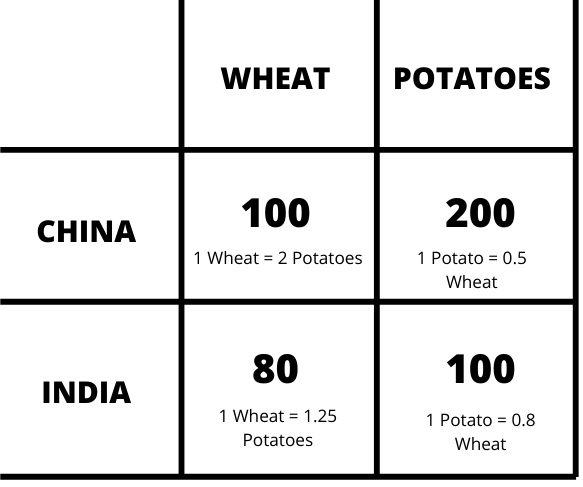
Identifying Comparative Advantage
As we can see from the table above, China has an absolute advantage in producing both Wheat and Potatoes. However, which country has a comparative advantage?
We can tell this by first looking at the product and then comparing the opportunity cost to each country. So in this example, the opportunity cost of making wheat in China is 2 potatoes. By contrast, it is only 1.25 in India. Therefore, the country that has the lowest opportunity cost has the comparative advantage. So in this case, India would have the comparative advantage in Wheat production and should focus on this.
If we now look to the production of potatoes, China has an opportunity cost of 0.5. In other words, it must sacrifice 0.5 wheat. At the same time, India has an opportunity cost of 0.8. So when we look at the nation with the lower opportunity cost, it would be China that has the comparative advantage. Therefore China should focus on producing potatoes, whilst India focuses on wheat.
Related Topics
FAQs
Comparative advantage stems from opportunity cost. So India may have to sacrifice 0.8kg of wheat for 1kg of potatoes. However, China may have to sacrifice only 0.5kg of wheat to produce 1kg of potatoes. So in this example, China has a comparative advantage in producing potatoes because it sacrifices the least.
When a nation has an absolute advantage, it is completely more efficient. That is to say, it can create a product at a lower cost. By contrast, a comparative advantage is where a country can produce a specific good at a lower opportunity cost. In other words, it has to give up less of one to get more of another.
A comparative advantage is where a nation is able to produce a product at a lower opportunity cost. For instance, a nation has to give up less of product A to make more of product B, whilst another nation may have to give up more of product B to make product A.
About Paul
Paul Boyce is an economics editor with over 10 years experience in the industry. Currently working as a consultant within the financial services sector, Paul is the CEO and chief editor of BoyceWire. He has written publications for FEE, the Mises Institute, and many others.

Further Reading
 Confidence Interval - A confidence interval is a range of values that provides an estimated range of plausible values for a population parameter,…
Confidence Interval - A confidence interval is a range of values that provides an estimated range of plausible values for a population parameter,… 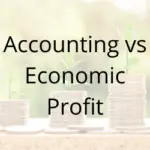 Accounting vs Economic Profit - The main difference between accounting and economic profit is that economic profit includes implicit costs. Whilst accounting profits include the…
Accounting vs Economic Profit - The main difference between accounting and economic profit is that economic profit includes implicit costs. Whilst accounting profits include the…  Fiscal Policy: Definition, Tools & Objectives - Fiscal policy refers to governments spending and taxation. So how much income it has coming in through taxes, and how…
Fiscal Policy: Definition, Tools & Objectives - Fiscal policy refers to governments spending and taxation. So how much income it has coming in through taxes, and how… 